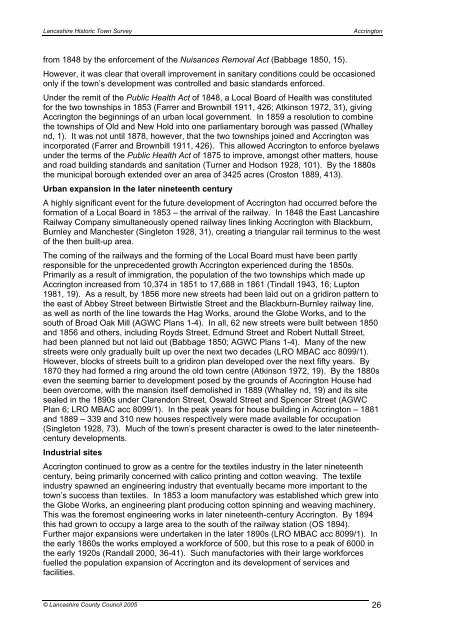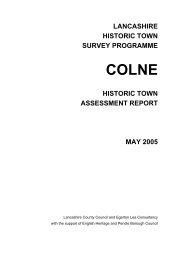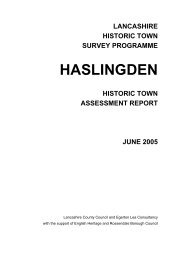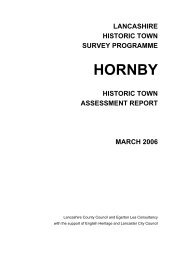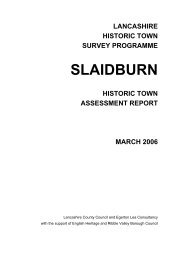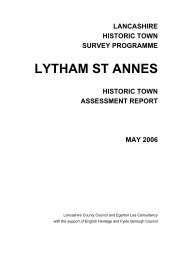ACCRINGTON - Lancashire County Council
ACCRINGTON - Lancashire County Council
ACCRINGTON - Lancashire County Council
Create successful ePaper yourself
Turn your PDF publications into a flip-book with our unique Google optimized e-Paper software.
<strong>Lancashire</strong> Historic Town Survey<br />
Accrington<br />
from 1848 by the enforcement of the Nuisances Removal Act (Babbage 1850, 15).<br />
However, it was clear that overall improvement in sanitary conditions could be occasioned<br />
only if the town’s development was controlled and basic standards enforced.<br />
Under the remit of the Public Health Act of 1848, a Local Board of Health was constituted<br />
for the two townships in 1853 (Farrer and Brownbill 1911, 426; Atkinson 1972, 31), giving<br />
Accrington the beginnings of an urban local government. In 1859 a resolution to combine<br />
the townships of Old and New Hold into one parliamentary borough was passed (Whalley<br />
nd, 1). It was not until 1878, however, that the two townships joined and Accrington was<br />
incorporated (Farrer and Brownbill 1911, 426). This allowed Accrington to enforce byelaws<br />
under the terms of the Public Health Act of 1875 to improve, amongst other matters, house<br />
and road building standards and sanitation (Turner and Hodson 1928, 101). By the 1880s<br />
the municipal borough extended over an area of 3425 acres (Croston 1889, 413).<br />
Urban expansion in the later nineteenth century<br />
A highly significant event for the future development of Accrington had occurred before the<br />
formation of a Local Board in 1853 – the arrival of the railway. In 1848 the East <strong>Lancashire</strong><br />
Railway Company simultaneously opened railway lines linking Accrington with Blackburn,<br />
Burnley and Manchester (Singleton 1928, 31), creating a triangular rail terminus to the west<br />
of the then built-up area.<br />
The coming of the railways and the forming of the Local Board must have been partly<br />
responsible for the unprecedented growth Accrington experienced during the 1850s.<br />
Primarily as a result of immigration, the population of the two townships which made up<br />
Accrington increased from 10,374 in 1851 to 17,688 in 1861 (Tindall 1943, 16; Lupton<br />
1981, 19). As a result, by 1856 more new streets had been laid out on a gridiron pattern to<br />
the east of Abbey Street between Birtwistle Street and the Blackburn-Burnley railway line,<br />
as well as north of the line towards the Hag Works, around the Globe Works, and to the<br />
south of Broad Oak Mill (AGWC Plans 1-4). In all, 62 new streets were built between 1850<br />
and 1856 and others, including Royds Street, Edmund Street and Robert Nuttall Street,<br />
had been planned but not laid out (Babbage 1850; AGWC Plans 1-4). Many of the new<br />
streets were only gradually built up over the next two decades (LRO MBAC acc 8099/1).<br />
However, blocks of streets built to a gridiron plan developed over the next fifty years. By<br />
1870 they had formed a ring around the old town centre (Atkinson 1972, 19). By the 1880s<br />
even the seeming barrier to development posed by the grounds of Accrington House had<br />
been overcome, with the mansion itself demolished in 1889 (Whalley nd, 19) and its site<br />
sealed in the 1890s under Clarendon Street, Oswald Street and Spencer Street (AGWC<br />
Plan 6; LRO MBAC acc 8099/1). In the peak years for house building in Accrington – 1881<br />
and 1889 – 339 and 310 new houses respectively were made available for occupation<br />
(Singleton 1928, 73). Much of the town’s present character is owed to the later nineteenthcentury<br />
developments.<br />
Industrial sites<br />
Accrington continued to grow as a centre for the textiles industry in the later nineteenth<br />
century, being primarily concerned with calico printing and cotton weaving. The textile<br />
industry spawned an engineering industry that eventually became more important to the<br />
town’s success than textiles. In 1853 a loom manufactory was established which grew into<br />
the Globe Works, an engineering plant producing cotton spinning and weaving machinery.<br />
This was the foremost engineering works in later nineteenth-century Accrington. By 1894<br />
this had grown to occupy a large area to the south of the railway station (OS 1894).<br />
Further major expansions were undertaken in the later 1890s (LRO MBAC acc 8099/1). In<br />
the early 1860s the works employed a workforce of 500, but this rose to a peak of 6000 in<br />
the early 1920s (Randall 2000, 36-41). Such manufactories with their large workforces<br />
fuelled the population expansion of Accrington and its development of services and<br />
facilities.<br />
© <strong>Lancashire</strong> <strong>County</strong> <strong>Council</strong> 2005 26


